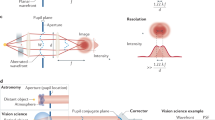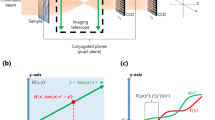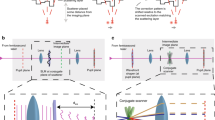Abstract
Adaptive optics can correct for optical aberrations. We developed multi-pupil adaptive optics (MPAO), which enables simultaneous wavefront correction over a field of view of 450 × 450 μm2 and expands the correction area to nine times that of conventional methods. MPAO's ability to perform spatially independent wavefront control further enables 3D nonplanar imaging. We applied MPAO to in vivo structural and functional imaging in the mouse brain.
This is a preview of subscription content, access via your institution
Access options
Access Nature and 54 other Nature Portfolio journals
Get Nature+, our best-value online-access subscription
$29.99 / 30 days
cancel any time
Subscribe to this journal
Receive 12 print issues and online access
$259.00 per year
only $21.58 per issue
Buy this article
- Purchase on Springer Link
- Instant access to full article PDF
Prices may be subject to local taxes which are calculated during checkout



Similar content being viewed by others
References
Booth, M.J., Neil, M.A.A., Juskaitis, R. & Wilson, T. Proc. Natl. Acad. Sci. USA 99, 5788–5792 (2002).
Vellekoop, I.M. & Mosk, A.P. Opt. Lett. 32, 2309–2311 (2007).
Popoff, S., Lerosey, G., Fink, M., Boccara, A.C. & Gigan, S. Nat. Commun. 1, 81 (2010).
Roorda, A. & Williams, D.R. Nature 397, 520–522 (1999).
Paterson, C., Munro, I. & Dainty, J. Opt. Express 6, 175–185 (2000).
Marsh, P., Burns, D. & Girkin, J. Opt. Express 11, 1123–1130 (2003).
Kam, Z., Kner, P., Agard, D. & Sedat, J.W. J. Microsc. 226, 33–42 (2007).
Zeng, J., Mahou, P., Schanne-Klein, M.-C., Beaurepaire, E. & Débarre, D. Biomed. Opt. Express 3, 1898–1913 (2012).
Ji, N., Milkie, D.E. & Betzig, E. Nat. Methods 7, 141–147 (2010).
Tao, X. et al. Opt. Lett. 36, 3389–3391 (2011).
Tang, J., Germain, R.N. & Cui, M. Proc. Natl. Acad. Sci. USA 109, 8434–8439 (2012).
Adie, S.G., Graf, B.W., Ahmad, A., Carney, P.S. & Boppart, S.A. Proc. Natl. Acad. Sci. USA 109, 7175–7180 (2012).
Wang, K. et al. Nat. Methods 11, 625–628 (2014).
Cižmár, T. & Dholakia, K. Nat. Commun. 3, 1027 (2012).
Park, J.H., Sun, W. & Cui, M. Proc. Natl. Acad. Sci. USA 112, 9236–9241 (2015).
Mertz, J., Paudel, H. & Bifano, T.G. Appl. Opt. 54, 3498–3506 (2015).
Yasuda, R. et al. Sci. STKE 2004, pl5 (2004).
Davalos, D. et al. Nat. Neurosci. 8, 752–758 (2005).
Dana, H. et al. PLoS One 9, e108697 (2014).
Nimmerjahn, A., Kirchhoff, F., Kerr, J.N. & Helmchen, F. Nat. Methods 1, 31–37 (2004).
Chen, T.-W. et al. Nature 499, 295–300 (2013).
Acknowledgements
This work was funded by NIH grant no. 1U01NS094341-01 and Purdue University. The authors thank W. Gan for valuable discussion and advice; G. Holtom and B. Wei for their help on manuscript preparation; and the Howard Hughes Medical Institute for equipment support. J.-H.P. thanks the NRF (grant no. 2016R1C1B2015130) for support during the manuscript preparation; and L.K. thanks the NSFC (grant no. 61327902) for support during manuscript revision.
Author information
Authors and Affiliations
Contributions
M.C. invented MPAO, developed the experimental schemes of wavefront correction and nonplanar imaging, designed the liquid-immersion-based tunable prism array, and supervised the project. J.-H.P. and M.C. designed the MPAO-based two-photon imaging system. J.-H.P. developed the wavefront measurement and correction algorithm, implemented the imaging system, and performed structural imaging of neurons and dynamic imaging of microglia. L.K. designed and performed structural imaging and calcium imaging of neurons, dynamic imaging of microglia, and nonplanar imaging of blood vessels and neurons (data shown in Figs. 1,2,3 and Supplementary Figs. 6,9,10,11,12). Y.Z. supported the system development, performed structural imaging of neurons and microglia, and assisted with figure preparation. M.C. and L.K. wrote the manuscript with input from all authors.
Corresponding author
Ethics declarations
Competing interests
The authors declare no competing financial interests.
Integrated supplementary information
Supplementary Figure 1 Design of MPAO based laser scanning two-photon fluorescence microscope.
Different from conventional AO based microscopes, we inserted two prism arrays at the focal planes between the two pairs of relay lenses, which generated a two-dimensional array of pupil images on the SLM. The Galvo mirror aperture was 5 mm in diameter, which was demagnified in the ratio of 11:15 by L1 and L2 and then magnified 50:11 by L3 and L4. The beam diameter at the pupil plane of the objective lens (Nikon 25× NA 1.1, full pupil 17.6 mm) was 16.7 mm, resulting in an effective excitation NA of 1.04.
Supplementary Figure 2 Design of the tunable prism array.
(a, b) We immersed the fused silica prism array in refractive index matching liquid (Cargille, Laser liquid, code 1074 and 3421). Controlling the refractive index of the immersion media allowed us to adjust the beam tilting angles. By using two liquids of different refractive indices (one higher and one lower than that of fused silica), we formed the complementary prism arrays. The angle tilt caused by one prism array was canceled by the other array. (c) 3D rendering of the 3×3 prism array. The size of each facet of the prism is 9.375 × 9.375 mm2. The angle between the purple facets (corners) and the central facet is 31.5 degree and the angle between the green facets and the central facet is 23.4 degree. The central thickness of the prism array is 10 mm.
Supplementary Figure 3 Wavefront measurement using image areas of different sizes as feedback.
As biological tissue is inhomogeneous, the aberration is position-dependent. Therefore, optimizing the wavefront within a small region could yield high-quality correction albeit with a small effective correction FOV. In comparison, optimizing the wavefront over a large region could increase the correction FOV albeit with reduced correction quality. Here we compare the in vivo imaging results obtained by using system correction (a) and by using 50 × 50 (b), 100 × 100 (c), 150 × 150 (d) μm2 area as the feedback during Zernike mode based wavefront optimization at 50 μm depth under the dura of Thy1-YFP mice. For these measurements, we used conventional AO microscopy (not MPAO) and the Full correction compensates both system aberration and sample aberration. The imaging FOV was 200 × 200 μm2 and the sample aberration wavefront of each measurement is also shown (e). The solid white boxes indicate the regions which were used as the feedback during wavefront optimization. (f) Intensity plot across the red line in d. (g) Intensity plot across the cyan line in d. Experimentally, we chose 150 × 150 μm2 area as the feedback area and as the image segment size in MPAO as a compromise between the correction quality and the effective correction FOV. By using prism arrays of different sizes, we can switch between different segment sizes for different biological tissues in MPAO (see Supplementary Note 4). The data shown in this figure is representative of two experiments.
Supplementary Figure 4 Quantitative comparison between MPAO and conventional AO methods.
(a) Maximum intensity projection of the 3D volume shown in Fig. 1. The yellow lines indicate the positions of cross-section plot (b-j). (k) We compare MPAO with Full average (conventional AO using the entire image as feedback during wavefront measurement) and Full single (conventional AO using the central image segment as feedback during wavefront measurement). The signals are normalized by the system correction signal values. The data shown in this figure is representative of three experiments.
Supplementary Figure 5 High-resolution large-volume imaging of resting state microglia.
(a) 3D rendering of microglia recorded by MPAO within a 450 × 450 × 300 μm3 volume. (b) MIP of a 20 μm thick x-z image stack (the vertical plane marked by the yellow arrow in a). Zoomed-in views show the comparison of full correction and system correction. (c) Long-term dynamic imaging of the vertical stack shown in b. We overlay two stacks recorded at different time (t = 0 and 45.9 min). (d) Imaging fast dynamics within a 50 μm thick x-y image stack (the horizontal plane marked by the white arrow in a). The GFP-expressing leukocytes (marked by red arrows) trafficking through brain vasculatures were recorded during the time-lapse recording (Supplementary Video 2). Scale bar: 50 μm. The data shown in this figure is representative of two experiments.
Supplementary Figure 6 3D rendering of the tissue volume around the ablation site.
(a) Resting state microglia before laser ablation. (b) Activated microglia after laser ablation. Volume size: 166 × 166 × 35 μm3. The dynamics is shown in Supplementary Video 3. The data shown in this figure is representative of three experiments.
Supplementary Figure 7 High-resolution large-volume deep-tissue imaging of neurons.
(a) 3D rendering of neurons recorded by MPAO within a 450 × 450 × 550 μm3 volume. (b, c) MIPs along z of 50 μm thick image stack centered at the depth of 75 and 325 μm, respectively. (d) The x-y image at 623 μm under the dura. The insets show the zoomed-in view to compare the images with full (tissue aberration + system aberration) and with system wavefront correction at different positions and depths. Red arrows, spines on basal dendrites of layer 5 neurons. Scale bars: 50 μm in b-d, 20 μm in the zoomed-in view. The data shown in this figure is representative of three experiments.
Supplementary Figure 8 Position-dependent aberrations at the shallow layer of mouse neocortex.
MIPs along z axis of 10 μm thick tissue volume at a depth of 75 μm acquired with system correction (a), full correction (b), single correction using the wavefront marked by the white arrow (c) and the red arrow (d) in b. The wavefront profiles are shown, with the amplitude scaled to the laser wavelength of 935 nm. Scale bar: 50 μm. The data shown in this figure is representative of two experiments.
Supplementary Figure 9 Deep imaging of neural dendrites and spines.
(a, b) MIPs along z axis of the tissue volume at 430-470 μm under the dura with full and with system correction, respectively. The wavefront profiles for the nine regions measured at the depth of 450 μm are shown in a. The wavefront amplitude is scaled to the laser wavelength of 935 nm. Scale bar: 50 μm. (c, d) The zoomed-in view of the area enclosed by the red box in a with full and with system correction, respectively. Scale bar: 20 μm. (e, f) MIPs along z axis of the tissue volume at 510-530 μm under the dura with full and with system correction, respectively. The wavefront profiles for the nine regions measured at the depth of 520 μm are shown in e. Scale bar: 50 μm. (g, h) The zoomed-in view of the area enclosed by the red box in f with full and with system correction, respectively. Scale bar: 50 μm. (i, j) MIPs along z axis of the tissue volume at 630-670 μm under the dura with full and with system correction, respectively. The wavefront profiles measured at the depth of 650 μm are shown in i. Scale bar: 50 μm. (k, l) The zoomed-in view of the area enclosed by the red box in j with full and with system correction, respectively. Thin arrows: the spines on the basal dendrites; thick arrows: neurites around the soma; scale bar: 10 μm. The data shown in this figure is representative of three experiments.
Supplementary Figure 10 Calcium imaging of neurons at a depth of 350 μm with MPAO.
(a, b) MIPs along z of SR101 stained astrocytes at 336-365 μm under the dura with full and with system correction, respectively. The wavefront profiles for the nine regions measured at the depth of 350 μm are shown in a. The wavefront amplitude is scaled to the laser wavelength of 935 nm. (c, d) Zoomed-in view of the central 150 × 150 μm2 area in a and b. (e, f) Standard deviation of the time-lapse images of GCaMP6s-expressing neurons with full and with system correction, respectively. c-f are from the same area. (g) Composite view of astrocytes (magenta) and neurons (green) at a depth of 350 μm. (h) ROIs for computing calcium transients. (i) Calcium transients with full and with system correction. Part of the calcium transient is also shown in Supplementary Video 5. Scale bars: 50 μm. The data shown in this figure is representative of four experiments.
Supplementary Figure 11 MPAO enabled nonplanar imaging.
(a, b) MIPs along z axis of the images acquired with full and with system correction, respectively. Each of the image segments was from a 50 μm thick image stack at a different depth. The tissue induced wavefront aberration is shown in a. The wavefront amplitude is scaled to the laser wavelength of 935 nm. Scale bar: 50 μm. (c) The zoomed-in view of the area enclosed by the red dashed box in b with full and with system correction, respectively. Scale bar: 20 μm. (d) The 3D distribution of the central planes of the nine image segments (Supplementary Video 6). We show the depth in micron for each plane. The data shown in this figure is representative of three experiments.
Supplementary Figure 12 Signal improvement by MPAO in nonplanar imaging.
(a, b) The maximum intensity projection of the volume across 60 μm in depth (6-65 μm under dura), with full correction and system correction, respectively. (c) Signal intensity along the red dash line in b. The data shown in this figure is representative of three experiments.
Supplementary Figure 13 Zernike mode optimization results for one mode used in Fig. 1.
(a) The image intensity variation for the nine image segments as a function of the applied Zernike mode. The Gaussian fitting returns the center position, which is the needed coefficient for this applied Zernike mode. (b) After the measurement, we add the corresponding amount of the measured Zernike mode to the SLM. The entire process repeats for each mode and the final wavefront displayed on the SLM is the summation of all the measured Zernike modes.
Supplementary Figure 14 Dependence of wavefront correction quality on the axial deviation from the measurement plane.
For volumetric imaging, we measured the wavefront every 50 μm in depth. After the wavefront measurement, we carried out imaging within ± 25 μm from the wavefront measurement plane. Here we show the signal improvement (the ratio of Full correction signal to System correction signal) measured in vivo from the dendrites of Thy1-YFP mice at 125-175 μm depth. The wavefront measurement plane was at the center of the image stack (150 μm deep). The data shown in this figure is representative of three experiments.
Supplementary information
Supplementary Text and Figures
Supplementary Figures 1–14, Supplementary Notes 1–4 and Supplementary Table 1. (PDF 4922 kb)
Supplementary Software
Matlab code for wavefront measurement. (ZIP 1 kb)
Volumetric imaging of microglia with different wavefront correction methods
We show the MIP of microglia along z axis (450 × 450 × 40 μm3 volume at the depth of 330-370 μm) recorded by system correction with MPAO, full correction with MPAO, full correction with an averaged wavefront (full average), and full correction with the wavefront measured from one region (full single, nine groups in sequence). (MP4 4872 kb)
Dynamic imaging of resting state microglia, dendritic cells and other leukocytes
MIP along z axis of the 450 × 450 × 50 μm3 volume at 0-50 μm under the dura. Using MPAO with full correction, we performed large FOV volumetric imaging of resting state microglia. In addition to the motion of microglia and dendritic cells, the video also captured GFP-expressing leukocytes trafficking in brain vasculatures. (MP4 16125 kb)
Dynamic imaging of microglia before and after the activation by laser ablation
MIP along z axis of the 450 × 450 × 35 μm3 volume at the depth of 330-365 μm. Using laser ablation, we introduced tissue damage, and employed MPAO with full correction to record the activated microglia dynamics. (MP4 7542 kb)
3D rendering of MPAO recorded layer 5 neurons
The image volume was 450×450×550 μm3. We show the volume data with system and with full correction for comparison. (MP4 29851 kb)
Large-FOV calcium imaging at 15 Hz with full correction by MPAO
In the video, we show the partial data of the calcium transient in Supplementary Fig. 10. The imaging FOV is 450 × 450 μm 2. (MP4 29406 kb)
3D image stack with the depth information of each image segment in the nonplanar image recording
The image in Supplementary Fig. 11d is extracted from this video. Magenta: the 3D image stacks. Green: the planes defined by the defocusing wavefront in nonplanar imaging. The imaging FOV is 450 × 450 μm2. (MP4 6523 kb)
Nonplanar imaging of 3D neurovasculature regulation
The plot in Fig. 3e is extracted from this video. The imaging FOV is 450 × 450 μm 2. (MP4 20490 kb)
Rights and permissions
About this article
Cite this article
Park, JH., Kong, L., Zhou, Y. et al. Large-field-of-view imaging by multi-pupil adaptive optics. Nat Methods 14, 581–583 (2017). https://doi.org/10.1038/nmeth.4290
Received:
Accepted:
Published:
Issue Date:
DOI: https://doi.org/10.1038/nmeth.4290
This article is cited by
-
Computational conjugate adaptive optics microscopy for longitudinal through-skull imaging of cortical myelin
Nature Communications (2023)
-
Deep learning-driven adaptive optics for single-molecule localization microscopy
Nature Methods (2023)
-
Recent advances in optical imaging through deep tissue: imaging probes and techniques
Biomaterials Research (2022)
-
Deep tissue multi-photon imaging using adaptive optics with direct focus sensing and shaping
Nature Biotechnology (2022)
-
A practical guide to scanning light-field microscopy with digital adaptive optics
Nature Protocols (2022)



